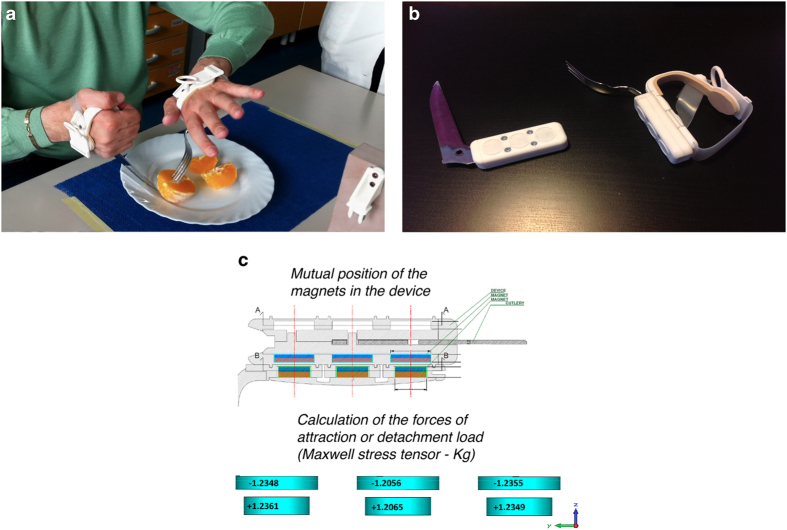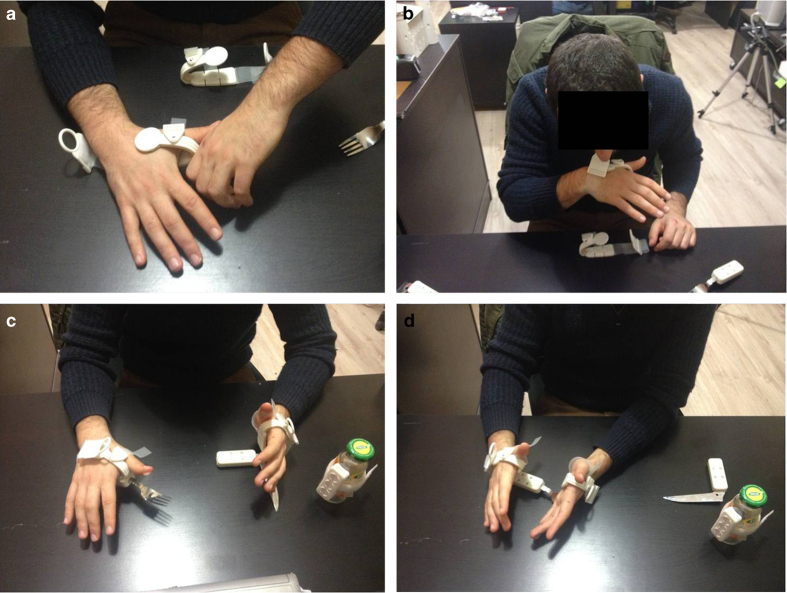Abstract
Study design:
Case report.
Objectives:
The objective of this study was to evaluate whether a new custom-made magnetic device might enable a patient affected with quadriplegia to self-feed.
Setting:
Day Hospital of the Unipolar Spinal Unit, CTO Hospital, Turin, Italy.
Methods:
Three magnets were affixed to a custom-made device and to a specially modified cutlery and a bottle of water.
Results:
The magnetic device permitted the patient to feed himself autonomously, using both a knife and a fork to eat and a bottle of water to drink.
Conclusion:
Such a magnetic device might be useful for self-feeding in a patient with quadriplegia.
Introduction
The degree of functional recovery of the upper limbs is of paramount importance for the quality of life of patients suffering from cervical spinal cord injuries and is therefore a focus of rehabilitation regimens. In this regard, it is not always possible to achieve an adequate level of functioning in some everyday activities, such as feeding and drinking.
In particular, the lack of grasp considerably affects the ability to handle both a knife and a fork during a meal or to have a drink of water. In fact, patients affected with quadriplegia are very often able to take in food by themselves, but they cannot cut it autonomously.
These limitations can necessitate assisted feeding,1 a major problem for people with quadriplegia, as it can negatively impact their social lives, particularly during mealtimes.
Case report
A 23-year-old man affected with C6 incomplete quadriplegia, American Spinal Cord Injury Association (ASIA) Impairment Scale C, following a home accident, was admitted for follow-up care to the Day Hospital of the Unipolar Spinal Unit of CTO Hospital, Turin, Italy.
The patient was very concerned about self-feeding, as he required a caregiver to cut his food and to aid him with taking a glass with his hands for the purpose of drinking. He normally used a modified version of standard cutlery, which he found very cumbersome, resulting in feelings of profound dissatisfaction during his meals.
To ameliorate the autonomy of the patient, a custom device based on magnetic attraction was designed and built. It was composed of a plastic material with a U shape, fastened through a Velcro system linked to an adjustable silicone belt (Figure 1). A silicone belt was also used to stabilize the apparatus on the first finger. A system of three magnets developed to be used with the device was installed on the device and on the modified cutlery. A set of three magnets contained in a Velcro belt was also prepared to be easily attached to a bottle of water.
Figure 1.
(a) The subject cut the food autonomously; (b) the custom-made magnetic device; (c) mutual position of the magnets and forces involved to attach and detach the device.
The subject was then invited to try the device during the consecutive follow-up. The patient himself did not need any assistance to wear the device. He put his hand into the device with the magnets in the palm of the hand and he fastened the device pulling the plastic ring with his teeth (Figure 2).
Figure 2.
(a) The subject puts his hand into the device; (b) the subject fastens the device pulling the plastic ring with his teeth; (c) the attachment of the ‘magnetized’ objects; (d) the exertion of a constraint on the objects allows the patient to release the object.
An explanation of how the ‘magnetized’ objects are attached and released from the device was made. In this respect, the exertion of a constraint on the secured objects allows the patient to easily release the object itself. In fact, because of the magnetic properties, rotation movements such as forearm pronation or supination permit the gradual separation of the two magnetic surfaces with a very low-energy expenditure. Our subject was then evaluated during meal wearing the device on both hands.
He was found to be able to cut the food independently (Figure 1), eat in autonomy and to have a drink of water simply by releasing the cutlery and securing the prepared bottle (the subject reported he had been unable to cut food by himself since the occurrence of the accident).
Discussion
Spinal lesions between the C5 and the C7 segment are often associated with normal or subnormal strength in the biceps and deltoids and a reduced or a complete inability to perform intrinsic hand movements, primarily resulting in a lack of grasp, which affects the ability to handle both the knife and fork during a meal or to easily drink while eating.
It has been well documented that assisted feeding and the attendant change in eating appearance are associated with feelings of isolation during mealtimes and consequent lower self-esteem.1
This custom-made device allowed the patient to feed and drink in almost complete autonomy. The only caregiver support required was the adjustment of the device for the first use and the placement of the portable magnets on the bottle of water.
For those affected with quadriplegia, the lack of dexterity impacts on ability to explore and interact with the environment and presents a marked obstacle towards their autonomy and therefore exerts a negative influence on their quality of life.
The utilization of magnetic devices might allow those with cervical spinal cord injury to boost their independence, with potential applications beyond those explored in this study such as facilitating autonomous shaving and/or tooth brushing, through the modification of a razor or a toothbrush.
Further studies are still needed to assess the specific long-term benefits of the use of this innovative tool.
The authors declare no conflict of interest.
References
- Martinsen B, Harder I, Biering-Sorensen F. The meaning of assisted feeding for people living with spinal cord injury: a phenomenological study. J Adv Nurs 2008; 62: 533–540. [DOI] [PubMed] [Google Scholar]




